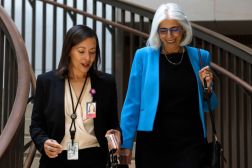White House 2014: Departures, digital service and Google
At the executive level, 2014 was a year of change for federal IT. Former federal Chief Information Officer Steven VanRoekel left his post and moved to the U.S. Agency for International Development as chief innovation officer, and Chief Technology Officer Todd Park left the top spot to return home to California and recruit top technology talent for the administration.
Although the White House has yet to announce a permanent pick to replace VanRoekel, former Google Vice President Megan Smith was selected shortly after Park’s departure to take over his CTO vacancy. Since then, Smith has participated alongside the president during the national Hour of Code event and launched a dedicated federal Twitter account, @USCTO.
Prior to Park and VanRoekel’s departures, the White House launched the U.S. Digital Service team and put Mikey Dickerson, a former Google engineer and one of the minds behind the late-2013 save of Healthcare.gov, at the helm. Dickerson, who notably does not have business cards and only wears a suit when interacting with the president, said that if the team is a success, people won’t even know it existed in a few years because government technology would be fine.
“Interaction with the government shouldn’t be a thing that you automatically dread, things like filing your taxes,” Dickerson said in a White House video. “This is like on the list of things people usually mention in the same sentence as going to the dentist. It’s probably never going to be fun, but things like that should be a process that you go through and immediately forget about.”
In October, the president unveiled an executive order requiring federal agencies to upgrade their consumer-facing point of sale systems to now be capable of receiving chip-and-PIN related payments. In addition, the White House required all executive agency-released payment cards to be equipped with similar technology.
The announcement of increased cybersecurity efforts in payment systems came a few weeks before the White House announced that it had been the victim of a network breach on an unclassified network in the Executive Office of the President. The breach, which came alongside a similar one at the State Department and one that happened a few months before at the United States Postal Service, was just one in a series of data breaches at the federal and private sector level. While the USPS breach compromised the personal data of more than 800,000 current and former employees, the White House did not comment on what data was compromised during its breach.
Big Story of 2014
U.S. CIO Steven VanRoekel leaves to help USAID fight Ebola
By FedScoop · Friday, Sept. 19, 2014 · 9:58 am
Read more of our 2014 wrap-up coverage:
2014 Year-in-Review: Big names and big stories
Federal IT acquisition 2014: A year of reform
2014 forges a new, more comfortable relationship with cloud for government
Congress 2014: The year of unfinished business
Cybersecurity 2014: The battle for mindshare
Defense 2014: The year of strategies and women
FAA 2014: From UAS integration to NextGen
The FCC’s 2014 in the spotlight may be just the beginning
Health IT 2014: The push toward interoperable data
Patent and Trademark 2014: The downfall of a teleworking leader
Veterans Affairs 2014: The Year of Being Held Accountable
Federal workforce 2014: Hiring millennials and closing the STEM skills gap






